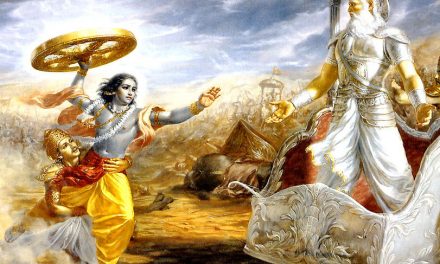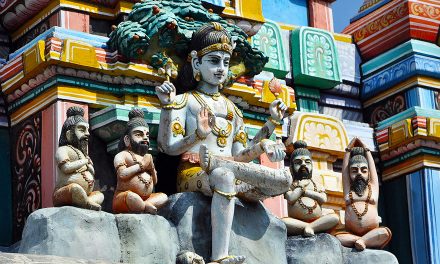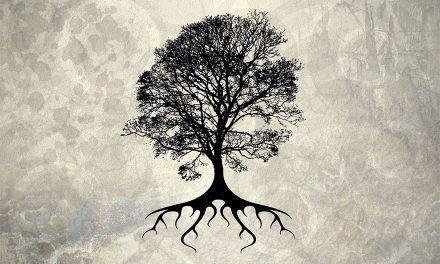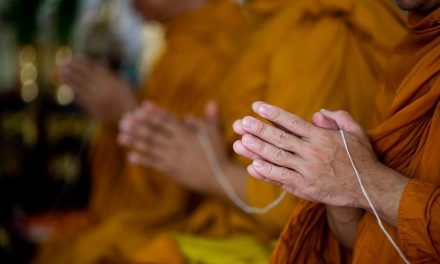The history and organization of the eight monasteries known as Ashta-Matts) in Udupi, Karnataka established by Sri Madhvacharya are most interesting. Udupi is one of the rarest Hindu religious centers, where the customs and routines as practiced by its founder have not been altered significantly for over seven centuries.
In the late 13th century, Sri Madhvacharya established the Krishna temple and the eight monasteries in Udupi. For seven centuries the monasteries have served as the bastions of Vaishnavism in India. It is one of the most sacred temples which boasts of many legendary saints, swamis as well as devotees. The monasteries have upheld the Dvaita (dualism) philosophy as proposed by Madhvacharya. Dvaita is acharya Madhva’s interpretation of the Upanishads and is incorporated in the philosophical branch of Darshana literature called Vedanta (end of Vedas).
Madhva was born in a village called Pajaka (Belle Grama) near Udupi. He was a prodigy who mastered Sanskrit and the Vedas at an early age and with the help of his guru Achutaprajna, amassed a wealth of knowledge from the Upanishads. Guru Achutaprajna was a proponent of monism (Advaita) and tried to indoctrinate young Madhva into that philosophy. However, Madhva from his observations formed his own opinions after an intense study of the Upanishads. Eventually he even convinced his guru to abandon Shankara’s theory of monism and adopt the dualistic theory of Dvaita. Guru Achutaprajna gave Madhva the name Purnaprajna after he completed and mastered the Vedas. Later he coronated (pattabhisheka) Madhva as a sanyasin and gave him the title Ananda Thirtha.
Acharya Madhva traveled the length and breadth of India to propagate his theory of dualism and won many disciples. There is a reference to one of his travels to North India when he was stopped by the Muslim rulers of Delhi, thought to be either Alauddin Khilji or Balban. Anyway, Madhva convinced the Muslim ruler that humans are children of the same God (Vishwakutumba). Impressed, the Sultan offered land and other amenities to Madhva, which he promptly refused. He asked for safe passage to Badrinath along with his disciples and the Sultan granted this.
Acharya Madhva not only was well versed in Vedas but also of the opinion that a healthy body was essential for a sound mind. He encouraged his disciples to exercise and build a strong body. He was also an ardent fan of wrestling. Acharya Madhva’s talents did not end there. He was a student of music and is considered to be the father of Carnatic music. He was a renowned singer of classical music. There are reports of him singing to a spellbound audience. Udupi, a part of Karnataka, was the hub of music because of Madhvacharya’s interest. Later this type of music spread all over South India and came to be known as Carnatic music (originated in Karnataka.)
Acharya Madhva was also interested in dance and drama. The unique indigenous folk dance called Yakshagana (a dance drama) is now thought to be the precursor of some of the well-known South Indian dances like Kuchipudi. Yakshagana was the medium created by Madhvacharya for the consumption of ordinary folks who were not well versed in the scriptures. He used this medium to educate the masses in spirituality. His disciple, Narahari Thirtha of Adumaru Matt was also instrumental in bringing this art to the forefront.
Yet the art of Yakshagana has moved away from Udupi, its birthplace, and has its base elsewhere in Tulu nadu today. A lack of support from the subsequent swamis of Udupi is blamed for this.
The Monasteries (Matts)
Madhvacharya established the Krishna temple of Udupi. The temple was built according to vastu shilpa. The idol was established facing west, which was a common practice at that time. (This was because the archaka can face east while performing puja. In temples where the idol faces east, the archaka is seen facing north, as he should never face west.) The idol could either be facing east or west, and both were acceptable according to Agama Shastra. This takes an important meaning, as we will see later as an urban legend tells the tale of devotee Kanakadasa, on whose account the idol of Krishna turned around 180 degrees so that the devotee could see Krishna’s face.
Acharya Madhva established the eight Tulu monasteries (Matts) in Udupi. The Matts were named in accordance with the names of the near by villages where they had the most assets. Thus Palimaru, Adumaru, Krishnapura, Puttige, Shiruru, Sode, Kaniyuru and Pejavara Matts came to be known as the Ashta-Matts of Udupi. Over centuries these monasteries upheld Madhva’s dualistic theory called Dvaita, which forms the basis of Hindu majority belief today. Uniquely, all the eight Matts are headquartered around the temple with their own buildings.
Sri Madhvacharya indoctrinated the eight disciples as swamis first. Later, when they were proficient in Vedanta, they were coronated (pattabhisheka) as heads of the eight Matts. In addition, he had a ninth disciple who did not have his headquarters in Udupi but was established over the Western Ghats. However, this Matt was closely aligned with Adumaru Matt. There is also close association between Udupi Matts and other nearby Matts. Subramanya Matt, Bhandarakeri Matt in Barkur and Bhimnakatte Matt in Thirthalli also belong to the Tulu family of Matts. Palimaru Matt and the well-known Matt in Gokarna (in Uttara Kannada; it is the gurupeeta for the Gowda Saraswat Brahmin society) are also considered as sister Matts.
When the swamis were coronated and placed on their thrones as heads of the various Matts, a suffix of ‘Thirtha’ was added to their names. Thus Hrishikesha Thirtha was the head of Palimaru Matt. He was the first disciple of Acharya to be coronated. The eight Matts are in this order:
Sri Hrishikesha Thirtha of Palimaru
Sri Nrisimha Thirtha of Adumaru
Sri Janardhana Thirtha of Krishnapura
Sri Upaendra Thirtha of Puttige
Sri Vamana Thirtha of Shiruru
Sri Vishnu Thirtha of Sode
Sri Rama Thirtha of Kaniyuru
Sri Adhokshaja Thirtha of Pejavara
The ninth Matt was headed by Sri Padmanabha Thirtha and is called Deshastha Matt. Each one of these Matts was also assigned a deity, but only four forms of Vishnu were chosen. They are Rama, Narasimha, Varaha, and Krishna (or Vittala). Each one of these deities represents the first syllable of the sacred ‘AUM’ (or OM that has four distinct sounds).
During Acharya Madhva’s time the organization of the Matts was slightly different than now. There were three swamis in each Matt. The oldest swami, on the verge of retirement was not involved in the administration of the Matt’s affairs. Instead, he concentrated on teaching the youngest trainee swami as well as spent his time in meditation. The younger swami was in charge of the daily affairs of the Matt as well as performed other obligatory functions for the spiritual uplift of the society in general. The youngest swami was usually a mere boy, being indoctrinated to ascend to the higher position. His training was the responsibility of the elder swami.
There was no rule that the swami had to be a bachelor. Even a married man could be chosen as the swami as long as he had renounced the worldly affairs and was willing to devote his life in the service of Lord Krishna.
Many palm leaf scrolls belonging to 14th century onwards are preserved in various Matts in Udupi. They are both in the Kannada and Tulu scripts. Many have been lost because of poor preservation technique. Some have made it to the modern print media and have been published. Many more need to be translated and published.
Literature
Researcher Bannanje Govindacharya has had the privilege of seeing many of the preserved texts from the Matts. With his immense knowledge and interest, Govindacharya has an advantage, as he is proficient in Sanskrit, Kannada and Tulu scripts. He has been able to read the document that is in Palimaru Matt, written by none other than the first disciple of Acharya Madhva, Sri Hrishikesha Thirtha. The palm leaf scroll written in beautiful handwriting is the replication of his guru Madhvacharya’s works. The work had been read and blessed by Acharya Madhva himself. Two other creations called “Sampradaya Paddhati” and “Anu Madhva Charite” are also credited to this Hrishikesha Thirtha, though there is not enough proof for this.
There were many more historians, poets and Vedantis amongst the many Swamis of the eight Tulu Matts of Udupi. There is a wealth of literature that has been preserved. A scroll describing the method of attaining ‘sanyasa’, a sort of guidebook for would be renouncers of worldly affairs was written by Sri Vishnu Thirtha of Sode Matt. It is called “ Sanyasa Paddhati”.
Another scholar was Sri Rajarajeshwara Thirtha of Palimaru Matt from the 14-15th century, who wrote several popular poems and bhajans. His creation “Ramasandesha” is compared to Kalidasa’s writings.
Of course, the most well known of all the Swamis is Sri Vadiraja from Sode Matt from the 16th century. Many other scholars lived and administered in Udupi Matt and their works and names are too many to enumerate here.
Swami Vadiraja (1480-1600)
After Acharya Madhva the most well known figure in Udupi is Swami Vadiraja He took over as the head of Sode matt in early sixteenth century. He was a reformer and a visionary par excellence. Originally Sode Matt was called Kumbasi matt as the major assets of the Matt were in Kumbasi. Swami Vadiraja defeated the Virashaiva guru of the local king in Vedantic discursions and established his base in the village of Sode. Since then the Matt has been called Sode.
Swami Vadiraja was not only a scholar but also a poet. He wrote hundreds of critiques and treatises to Acharya Madhva’s works as well as works of other Swamis before him. He was also mindful of the common people who needed guidance and directions in their devotion to Lord Krishna. Bhajan was an important part of daily routines of Hindus. Swami Vadiraja gave them innumerable songs including the famous ‘Shobhane’, which is recited even today by women at dusk every day as part of their prayer routine.
Swami Vadiraja also was a pioneer in reforming the administration of the Matts as regards to their obligations towards the puja ritual of the temple. Previously, various heads of Matts were in charge of puja at Krishna temple for a period of two months at a stretch. He introduced the ceremony of Paryaya, when the designated Matt is in charge as overall administrators for a period of two years. The first Paryaya was held in the year 1522, when swami of Palimaru Matt took over as the overall administrator of the temple for a period of two years. Vadiraja (of Sode matt) himself became the head of Paryaya for the first time in 1532. The order of Paryaya was selected according to the order of the swamis being coronated by Madhvacharya (note the list above). In the year 1596, it was the turn of Sode Matt to take charge of Paryaya for the fifth time. Though Swami Vadiraja was alive at that time he let his younger disciple take over. Swami Vadiraja died in the year 1600 at the age of 120.
Today Paryaya ceremony in Udupi draws a global audience every two years. In the year 2000, a cycle of thirty Paryayas for each Matt was completed (478 years). In 2002, Palimaru swami took over to begin yet another cycle (31st).
Swami Vadiraja was also the builder of the famous Kanaka-na-kindi (Kanaka’s window) on the western wall of the temple, which had been devoid of windows. The swami restored the honor and dignity to Kanakadasa, who was an ardent devotee of Lord Krishna in Udupi.
Kanakadasa (1508-1606)
Kanakadasa is a legendary figure in Udupi. Born to a shepherd family near Dharwar, he did not have the power or the status of a higher caste Hindu. He was a devotee of Thirumalai Venkateshwara and his devotion to Krishna was extraordinary. This quintessential devotee composed and sang countless songs in praise of Lord Krishna. When he was not allowed to enter the temple to see his favorite God because of a caste dispute, he stood outside the western wall of the temple for days and nights, singing and pleading Krishna to give him audience (darshan). Legend has it that the idol of Krishna, which heretofore had been facing east, turned around to face west, as the western wall collapsed so that Kanakadasa could see the face of his favorite idol.
The construction (according to vastu shilpa) of the temple does not support this legend. The idol had always been facing west as evidenced by the other structures built in the ancient temple, around the idol of Krishna. The main entrance to the sanctum sanctorum is, as always from the east. There is a pond called Madhva Sarovara on the eastern front of the main entrance. When denied entrance into the temple, the only place Kanaka could have stood and prayed was the outside the western wall on the street.
However, it is believed that there was a minor earthquake at night when Kanakadasa was singing outside the western wall. A crack appeared in the western wall and Kanakadasa was able to see the idol of Krishna in plain view. In a composition of Kanakadasa, he makes a reference to the shaking of the earth at night, while he was praying with his eyes closed.
Apart from Acharya Madhva who himself composed devotional songs of Krishna, Sri Narahari Thirtha is considered to be the father of Haridasa (servant of Vishnu) movement in Udupi. Three other swamis of Udupi were also patrons of Haridasa movement namely Sri Padaraja Thirtha, Sri Vyasaraja Thirtha and Sri Vadiraja Thirtha. Sri Vyasaraja gave an impetus to the Dasa movement by taking both Kanakadasa and Purandaradasa as disciples. Another disciple, Sri Vadiraja, who was a contemporary of Kanakadasa, rebuilt the western wall of the temple with a window. This window came to be known as Kanaka-na-kindi (Kanaka’s window). The nine partitions in the window signify the nine pores of the human body (eyes, ears, nostrils, and the two pores for excretion, and the mouth). The temple is considered to be the human body with the idol occupying the heart and the window thus becomes as part of the human body. The memory of Kanakadasa was permanently etched in the temple of his beloved Lord Krishna, thanks to Sri Vadiraja. He also established a gudi (a cottage) in memory of Kanakadasa where he had stayed. Recital of Vedas was a daily occurrence here for many centuries. Today a statue of Kanakadasa has replaced the gudi.
Ironically, the entrance to the temple was denied to a lower caste member like Kanakadasa in a temple of Krishna, who himself belonged to the lower caste of cowherds. Krishna even had set an example by refusing the invitation to stay with Bhishma or Drona when he visited Hastinapura but stayed with lower caste Vidura. Yet the upper class had forgotten the moral example set by their own Lord Krishna and in their narrow sightedness denied Bhakta Kanakadasa entrance to the temple. Though Kanakadasa is immortalized in Udupi, the caste-warfare and discrimination sadly still exist.













